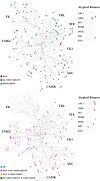Identifying and evaluating understudied protein kinases using biological and chemical criteria
- PMID: 40510904
- PMCID: PMC12152735
- DOI: 10.1039/d5md00306g
Identifying and evaluating understudied protein kinases using biological and chemical criteria
Abstract
Protein kinases (PKs) play a central role in cellular signaling. Uncontrolled signaling by deregulated PKs is implicated in a variety of diseases. As a consequence, PKs are among the most popular pharmaceutical targets. The preferred strategy for therapeutic intervention of medical conditions caused by deregulated PKs is the inhibition of their catalytic phosphorylation activity. Accordingly, small-molecular PK inhibitors (PKIs) have become a major drug class in oncology and prime candidates in other therapeutic areas. While cellular functions of many PKs and potential involvement in disease biology have been intensely investigated, others have received comparably little attention, leading to the identification of understudied 162 kinases representing the dark "dark kinome". Dark PKs have for the most part been categorized based on the absence of functional information and lack of reagents. Large-magnitude projects have been initiated to further explore and functionally characterize the dark kinome. In addition, different categories of PKs have also been defined based on their degree of chemical exploration in medicinal chemistry, representing complementary assessments of understudied PKs.
This journal is © The Royal Society of Chemistry.
Conflict of interest statement
There are no conflicts to declare.
Figures



Similar articles
-
Assessing Darkness of the Human Kinome from a Medicinal Chemistry Perspective.J Med Chem. 2024 Oct 10;67(19):17919-17928. doi: 10.1021/acs.jmedchem.4c01992. Epub 2024 Sep 25. J Med Chem. 2024. PMID: 39320975
-
Kinase Drug Discovery: Impact of Open Science and Artificial Intelligence.Mol Pharm. 2024 Oct 7;21(10):4849-4859. doi: 10.1021/acs.molpharmaceut.4c00659. Epub 2024 Sep 6. Mol Pharm. 2024. PMID: 39240193 Review.
-
Systematic Analysis of Covalent and Allosteric Protein Kinase Inhibitors.Molecules. 2023 Aug 1;28(15):5805. doi: 10.3390/molecules28155805. Molecules. 2023. PMID: 37570774 Free PMC article.
-
Using molecular simulation to explore the nanoscale dynamics of the plant kinome.Biochem J. 2018 Mar 9;475(5):905-921. doi: 10.1042/BCJ20170299. Biochem J. 2018. PMID: 29523701 Review.
-
The Kinome of Edible and Medicinal Fungus Wolfiporia cocos.Front Microbiol. 2016 Sep 21;7:1495. doi: 10.3389/fmicb.2016.01495. eCollection 2016. Front Microbiol. 2016. PMID: 27708635 Free PMC article.
References
-
- Attwood M. M. Fabbro D. Sokolov A. V. Knapp S. Schiöth H. B. Nat. Rev. Drug Discovery. 2021;20:839–861. - PubMed
-
- Ferguson F. M. Gray N. S. Nat. Rev. Drug Discovery. 2018;17:353–377. - PubMed
-
- Baselga J. Science. 2006;312:1175–1178. - PubMed
-
- Xie Z. Yang X. Duan Y. Han J. Liao C. J. Med. Chem. 2021;64:1283–1345. - PubMed
Publication types
LinkOut - more resources
Full Text Sources
Research Materials
Miscellaneous

